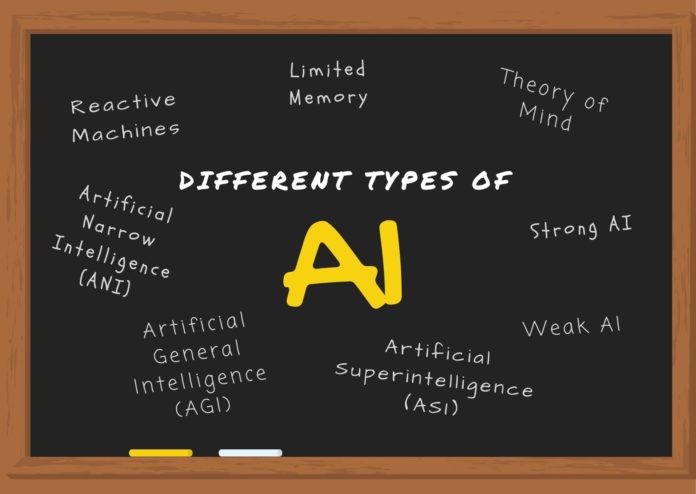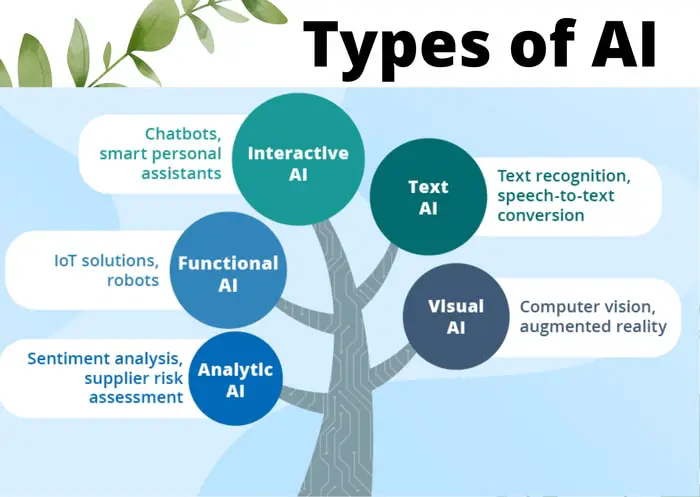Artificial intelligence is the mimic of the human brain. Almost all the sectors have reached the touch of AI. But the importance varies from segment to segment. So there is the requirement to study different types of artificial intelligence. Some of the books and websites show that there are 3 types of knowledge in AI. On the other hand, some people recommend 4 main categories of artificial intelligence. In our study, we found a total of 7 types of AI.
The 3 Types of AI
AI can be classified in different ways. There are three types of artificial intelligence in terms of functionality. On the other hand, there are 3 types of AI in terms of components. We will discuss all the classifications. 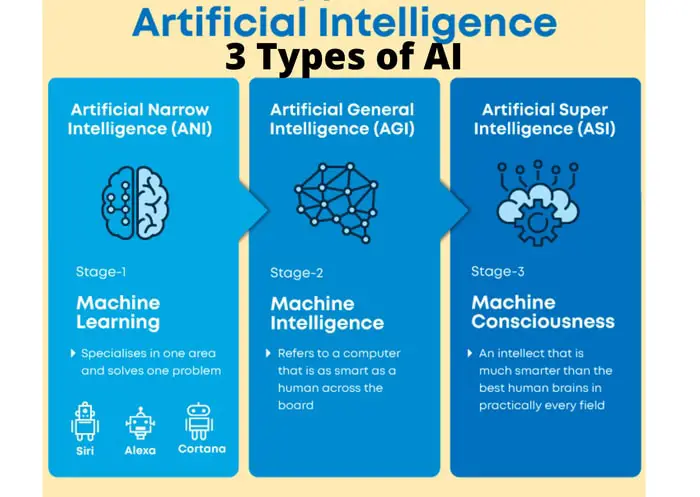
1. Artificial Narrow Intelligence (ANI)
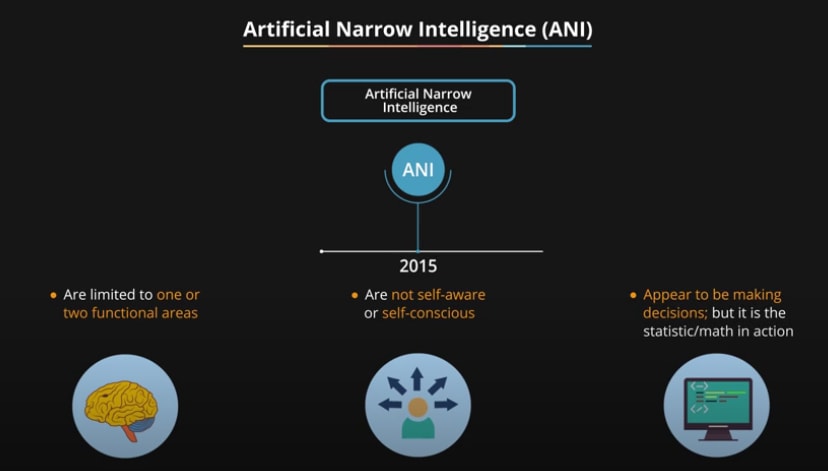 The machine is extremely good at doing one task but limited to extending its capacity to perform another task. It is widely known as narrow AI or weak AI. Narrow AI is limited to a specific area to perform a single task.
The machine is extremely good at doing one task but limited to extending its capacity to perform another task. It is widely known as narrow AI or weak AI. Narrow AI is limited to a specific area to perform a single task.
Artificial Narrow Intelligence (ANI) is widely known as narrow AI. It focuses on only narrow tasks or one problem. Weak AI and narrow AI are the same. However, it was the initial stage of artificial intelligence.
At present, AI is not referring to narrow AI. Instead, it refers to strong AI. Weak AI does not support simultaneous tasks. But, it does the job with the highest level of accuracy. It can not identify the reasons, but it can relieve you from doing a monotonous job.
Some examples of narrow AI:
- Google search and rankbrain by Google is the perfect example of weak AI.
- Virtual assistants of IBM’s Watson,
- Crawling a webpage or playing chess.
- Chatbot, Siri by Apple, Alexa by Amazon, Cortana by Microsoft are the perfect example.
2. Artificial General Intelligence (AGI)
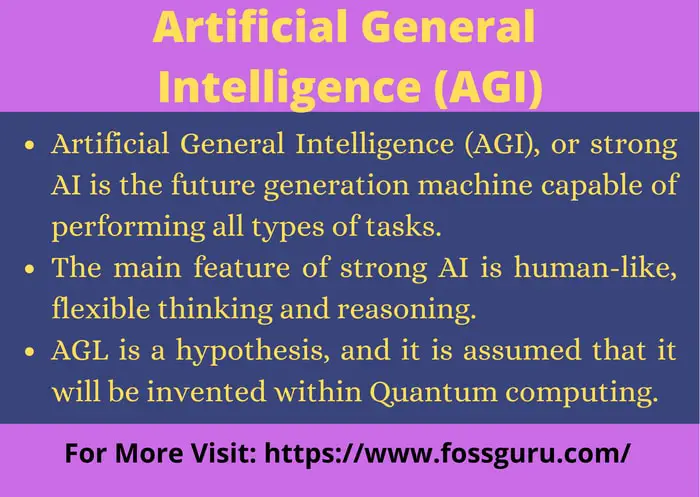 Strong AI is commonly known as Artificial General Intelligence (AGI). It is the superintelligence that suppresses human intelligence. It can mimic the cognitive abilities of the human brain.
Strong AI is commonly known as Artificial General Intelligence (AGI). It is the superintelligence that suppresses human intelligence. It can mimic the cognitive abilities of the human brain.
Strong AI is the perfect solution to solve the unfamiliar job. Whenever there are any difficulties and dissimilarities in making decisions, the strong AI can work there perfectly. Some of the readers ask the difference between AI and AGL. AGL is a part of AI. Some researchers think that AGL is not possible because it is not possible to model our brains.
Artificial General Intelligence (AGI), or strong AI is the future generation machine capable of performing all types of tasks. The main feature of strong AI is human-like, flexible thinking and reasoning. AGL is a hypothesis, and it is assumed that it will be invented within Quantum computing.
Example of AGI:
- Fuzzy logic for the next ten years.
3. Artificial Super Intelligence (ASI)
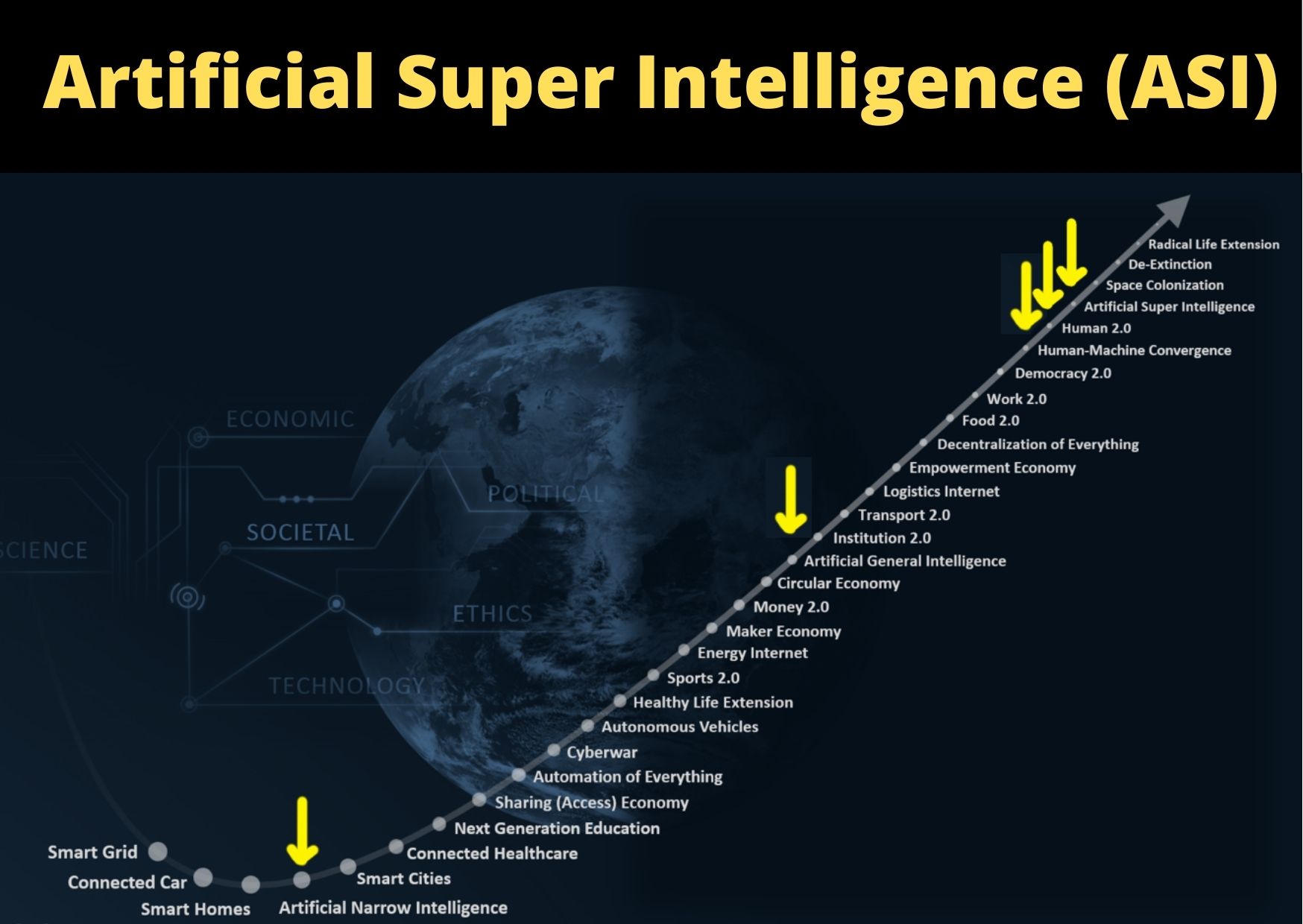 Artificial Super Intelligence (ASI) is the logical progression of AGI. It is a hypothetical AI that is beyond the human brain. ASI becomes self-aware and suppresses human capacity. It is based on science-fiction. In ASI, decision-making and problem-solving will be superior to human think Artificial Super Intelligence (ASI)ng.
Artificial Super Intelligence (ASI) is the logical progression of AGI. It is a hypothetical AI that is beyond the human brain. ASI becomes self-aware and suppresses human capacity. It is based on science-fiction. In ASI, decision-making and problem-solving will be superior to human think Artificial Super Intelligence (ASI)ng.
Engineers and scientists are still trying to achieve the functionalities of Artificial Super Intelligence (ASI). ASI is an imagination. We did not achieve it, but you can predict what will be happening after achieving it. It will represent humans with self-awareness and self vigilance. The human brain is limited to some billion neurons, but ASI has unlimited neurons.
Example of ASI:
- search engine algorithms like Rankbrain from Google,
- voice assistant
- a multitude of the face and biometric recognition solutions,
- e-commerce product recommendation tools
Another 3 Catagories of AI
When we discussed 3 types of AI, then we found three names which are Artificial Narrow Intelligence (ANI), Artificial General Intelligence (AGI), and Artificial Super Intelligence (ASI). ANI is narrow AI or weak AI, which is applicable for a specific task with limited memory. AGI is a strong AI that can compare with the thoughts of the mind. ASI is a superintelligence that does not exist till now.
The 4 types of Artificial Intelligence
In 2016 we got an idea regarding AI from professor Arend Hintze of Michigan State University. He said we could categorize AI into four types. Which are:
1. Reactive machines
Reactive machines are type 1 Artificial Intelligence that has no memory, and the task is specific. It does not tell previous experience and works only with predefined single logic. Reactive machines do not store previous memory to implement previous experience. Moreover, it is purely reactive and does not utilize pest experience.
Example of Reactive machines:
- Deep Blue, the IBM chess program. In 1990 it beat Garry Kasparov.
- Playing video games on PC.
2. Limited Memory Artificial Intelligence
Limited memory is the type 2 AI system. It has limited memory that can be referenced to future decisions. It is one kind of machine learning model that especially learns from facts and events. Limited memory learns from the previous history and implements experiential knowledge by observing actions or data.
Example of Limited memory:
- Self-driving cars
3. Theory of Mind
Theory of mind is psychological terminology. This social intelligence is applied to understand emotions. It predicts the behavior of human reactions. Computers are equipped with all types of emotions to read the human mind. It does not exist, but the development of the Theory of mind is in progress.
Example of Theory of mind
- Autonomous cars
4. Self-awareness AI
Self-awareness AI is the application of common sense by the machine. All the predefined data is stored in the system, so whenever it needs action, it works automatically. This type of AI does not exist.
Example of Self-awareness AI:
- Self-awareness robot
- Terminator movies
- Google SkyNet
- DeepMind AI system
Difference Between Strong and Weak Artificial Intelligence
Artificial intelligence mainly depends and differentiates based on robust and weak AI. Strong AI is a complex algorithm that acts on different algorithms. Weak AI or narrow AI is confined to limited functionality.
Out of the 2 major types of artificial intelligence, we will differentiate between weak and strong AI. Here are the fundamental differences between Strong and Weak Artificial Intelligence.
| Types of Difference | Strong AI | Weak AI |
| Definition | Strong artificial intelligence is a hypnotical machine that mimics human intelligence. | Weak Ai is the model view of intelligence that is used for a specific problem. |
| Problem Solving | Strong AI can think and solve problems on its own. | Weak AI is defined widely but can do only narrow tasks. |
| Behavior | It can exhibit strong cognitive behavior. | It does not have a mind of its own. |
| Learning | Strong AI stores data and relearning is possible. | Narrow AI does not save data and relearning is not possible. |
| Complexity | Strong artificial intelligence has complex algorithms and it can perform based on different situations. | Narrow AI based on simple algorithms to perform a specific type of work. |
| Application | Strong AI is a hypothetical concept that does not exist for us. We are proceeding towards this AI. | Weak AI is useable for chatbots, eCommerce, and specific tasks. |
| Example |
|
|
4 Types of Artificial Intelligence Based on Functionalities
- Sometimes we define four forms of artificial intelligence based on functionalities. Firstly, a reactive machine is the primary type of AI that can not use previous data. IBM’s Deep blue is an example of a reactive machine.
- Secondly, limited memory is the present form of AI that can look back past. Self-driving cars are examples of this type 2 AI.
- Thirdly, the Theory of mind is a famous thought of AI. It can mimic humans and evaluate humans.
- Finally, self-awareness AI is the future form of artificial intelligence. This type of AI does not exist. Within one decay, it will be available among us.
3 Forms of AI
In terms of business application, we can classify 3 forms of AI. It is applied in business. The three types of AI is given below:
1. Process automation
Artificial intelligence process automation studies cognitive automation, machine learning, robotic process automation, and Unattended Robotics. In a variety of business processes, it can reduce human intervention.
IPA is simple and goes beyond rule-based tasks. It is often regarded as robotic process automation (RPA). The application of AI and ML takes far beyond the back and front office tasks. Moreover, IPA leverages machine learning algorithms to calculate real-time and historical data.
2. Cognitive insight
Cognitive insight is a wing of AI that utilizes artificial intelligence algorithms to collect large amounts of data, compile and determining the data. It provides a detailed and accurate model for predicting trends of consumer buying patterns.
Examples of Cognitive insight:
- Finding the fraud of transactions
- Speed hiring processes
- automated job search and onboarding
- Automate advertisements and marketing
3. Cognitive Engagement
Cognitive engagement is the engagement of customers and businesses in practical ways with the use of AI. Nowadays, time is money. Customers want to know information within the shortest possible time. Implementation of an AI chatbot can be the best example of Cognitive engagement. It can serve up around-the-clock services. Moreover, Cognitive engagement ensures better service and consumer relations for further business expansion.
What are the 5 main types of artificial intelligence
Some of the experts thought there are broadly 5 types of artificial intelligence. This classification of AI is based on usability. The 5 main types of artificial intelligence categories are: 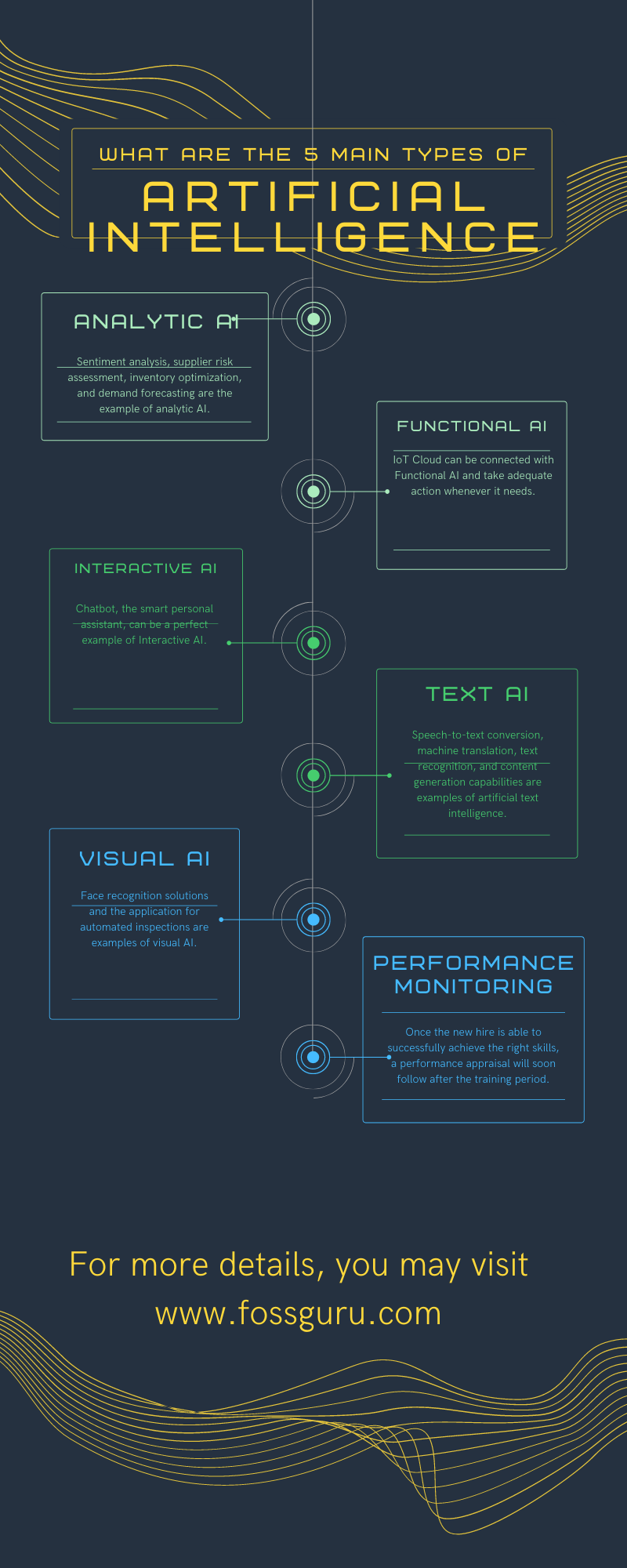
1. Analytic AI
Analytic AI is used for data-driven decision-making. It includes advanced-level deep learning and machine learning. Moreover, Analytic AI collects tons of data, processes and recommends the ultimate business insight.
Example of Analytic AI:
Sentiment analysis, supplier risk assessment, inventory optimization, and demand forecasting are the example of analytic AI.
2. Functional AI
Functional AI is similar to Analytic AI. It collects tons of data, processes and does not recommend it. Instead of recommendation, it goes for action.
Example of Functional AI:
IoT Cloud can be connected with Functional AI and take adequate action whenever it needs.
3. Interactive AI
Interactive AI is the interactive communication system that predicts the needs of users. It can interact with humans as naturally as humans.
Example of Interactive AI:
Chatbot, the smart personal assistant, can be a perfect example of Interactive AI. Conversation and process verification is another common example of Interactive AI.
3. Text AI
Text AI is the present form of artificial intelligence that can process text. Google, Amazon, Apple, and almost all the big organizations have text AI services.
Example of Text AI:
Speech-to-text conversion, machine translation, text recognition, and content generation capabilities are examples of artificial text intelligence.
4. Visual AI
Visual AI is the analysis and process of images, videos, and direct observations. In the manufacturing industry, we can see the Visual AI service.
Example of Visual AI:
Face recognition solutions and the application for automated inspections are examples of visual AI.
The 7 Types of Artificial Intelligence
According to Forbes, there are 7 types of artificial intelligence. The 7 categories of AI are Reactive Machines, Limited Memory, Theory of Mind, Artificial Narrow Intelligence (ANI), Artificial General Intelligence (AGI), and Artificial Superintelligence (ASI). Naveen Joshi, the writer of an article, showed all the 7 types of AI together. He showed all the classifications together.
What Are the Types of Knowledge in AI?
- There are five types of knowledge in artificial intelligence. First for AI is Declarative Knowledge. It includes concepts, facts, and objects that are simpler than procedural language.
- Second type if AI knowledge is Procedural Knowledge. This imperative knowledge is responsible for knowing the fact and ways to do it. Rules, strategies, procedures, agendas are the discussion point of Procedural Knowledge.
- The third type of AI is Meta-knowledge. It tells data regarding the data.
- Heuristic knowledge is the fourth type of AI knowledge that represents some expertises. It can refer to the experience.
- The fifth type of AI knowledge is Structural knowledge. It works for problem-solving and describes the relationship between object and concept.
Final Thought
Based on different scenarios, there are different types of AI. Business and science use it based on the requirement. The type of artificial intelligence depends on its uses and application. Technology is constantly changing, and different forms of AI are discovering for further application.





